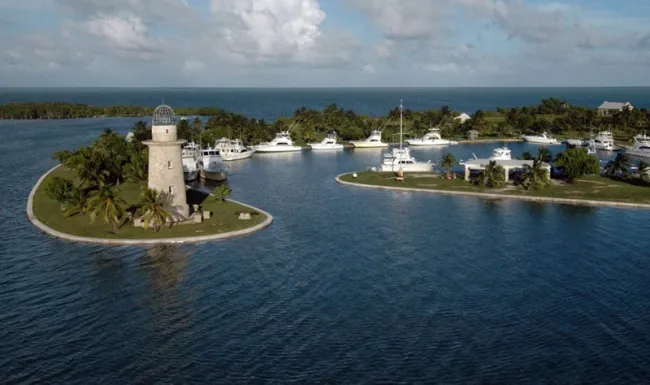
Biscayne National Park, located in South Florida, is a marine paradise encompassing over 172,000 acres, with 95% of its area covered by water. This unique park is celebrated for its crystal-clear waters, vibrant coral reefs, mangrove forests, and historic shipwrecks. Biscayne’s proximity to Miami makes it an easily accessible escape into nature, offering a range of water-based activities like boating, snorkeling, and scuba diving.
History of the Park
Biscayne National Park was established in 1968 to protect the Biscayne Bay area, which includes one of the most extensive coral reef systems in the United States. The area’s history stretches back thousands of years, with evidence of human habitation by Native American tribes. Spanish explorers and later settlers also made their mark. The park’s history is intertwined with the maritime industry, including shipwrecks that have become part of the Maritime Heritage Trail. The park officially became a national monument in 1968, and in 1980, it was upgraded to national park status to preserve its unique ecosystems and cultural history.
Main Features
- Coral Reefs: Biscayne’s vibrant coral reefs are the park’s centerpiece, drawing snorkelers and divers to explore the underwater world.
- Mangrove Forests: These coastal wetlands serve as critical habitats for fish, birds, and other wildlife, and help protect the mainland from storms.
- Shipwrecks: The Maritime Heritage Trail features several historic shipwrecks, accessible to divers and snorkelers.
- Boca Chita Key: This popular island features a historic lighthouse, picnic areas, and beautiful beaches.
- Elliott Key: The largest island in the park, Elliott Key offers hiking trails, picnicking, and camping opportunities.
- Jones Lagoon: A haven for kayaking and wildlife watching, especially for manatees and sea turtles.
Types of Trails
While Biscayne National Park is mostly water, there are a few land-based trails:
- Elliott Key Trail: This 7-mile loop on Elliott Key offers scenic views of the island’s natural beauty, passing through mangroves and coastal hammocks.
- Spite Highway: An old road on Elliott Key, this trail provides a unique hiking experience through the island’s interior.
Water trails are a significant feature here, with popular options for kayaking and paddleboarding through Jones Lagoon, where visitors can spot wildlife like manatees and sea turtles.
Crowd Expectations and Number of Annual Visitors
Biscayne National Park sees an estimated 500,000 visitors annually. The park’s visitor numbers peak in the winter and early spring months when the weather is cooler and more favorable for outdoor activities. Crowds are most noticeable on weekends, especially around popular spots like Boca Chita Key. Despite the number of visitors, the park’s vast expanse of water ensures there is always a sense of seclusion for those venturing offshore.
Accessibility for Seniors and Wheelchairs
- For Seniors: The park offers senior-friendly experiences, particularly in the form of boat tours, which allow visitors to explore the park’s beauty without extensive physical exertion. Boca Chita Key and Elliott Key have picnic areas and short, easy walks suitable for seniors.
- For Wheelchairs: Biscayne National Park is working to improve accessibility for visitors with mobility challenges. The Dante Fascell Visitor Center is fully accessible, with ramps and exhibits designed for wheelchair users. Boat tours from the visitor center often provide accommodations for wheelchairs, though it’s recommended to call ahead to ensure the specific boat has the necessary features.
Park Amenities
- Visitor Center: The Dante Fascell Visitor Center features exhibits on the park’s ecosystems, a small theater, and a gift shop. Rangers are available to answer questions, and several programs are offered, including guided tours.
- Restrooms and Picnic Areas: Available at various points in the park, including Boca Chita Key and Elliott Key.
- Boat Rentals and Tours: Multiple operators offer boat rentals, guided tours, and snorkeling trips, providing visitors with opportunities to explore the park’s water-based wonders.
Camping Facilities
Camping is available on Elliott Key and Boca Chita Key. Both islands offer basic campgrounds, with picnic tables and grills. However, there are no fresh water or electricity services, so campers need to bring their supplies. Reservations are not required, but campsites are available on a first-come, first-served basis. Camping fees are minimal, making this a budget-friendly way to experience the park.
Access to Lodging
There are no lodges or hotels within Biscayne National Park, but its proximity to Miami means that visitors can easily find accommodations nearby. From luxury hotels to budget-friendly motels, the options are diverse. Additionally, there are vacation rentals and marinas offering docking and amenities for those arriving by boat.
Pet-Friendliness
Pets are allowed on the park’s islands, such as Elliott Key and Boca Chita Key, but they must be kept on a leash no longer than six feet at all times. Pets are not permitted in the water or on the beaches to protect the park’s delicate ecosystems. It’s important to clean up after your pet and ensure they are not disturbing wildlife.
Best Months to Visit
The best time to visit Biscayne National Park is from December to April when the weather is mild, and the risk of hurricanes is low. During these months, temperatures are comfortable for outdoor activities, and water visibility for snorkeling and diving is at its best. Summer can be hot and humid, with frequent thunderstorms, but also offers opportunities for quieter visits. Hurricane season runs from June to November, so planning is crucial if visiting during this time.
Conclusion
Biscayne National Park is a hidden gem that offers a unique blend of land and sea experiences, with opportunities for adventure, relaxation, and wildlife observation. Whether you’re a snorkeling enthusiast, a history buff interested in shipwrecks, or someone simply looking to escape into nature, Biscayne’s rich ecosystem and proximity to Miami make it an accessible and memorable destination for all types of visitors. Plan your visit during the cooler months for the best experience, and don’t forget to explore both the underwater and terrestrial treasures that this park has to offer.



